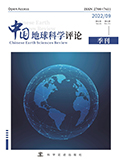

阿里札达县地形上位于青藏高原偏西南部分的札达盆地, 札达盆地恰位于喜马拉雅山脉与阿依拉山之间, 大体呈北东-南西向展布, 这与喜马拉雅以西地区北西-南东的构造线方向一致, 属于白垩纪末期印度板块和欧亚板块相互碰撞-俯冲-拼接汇聚的构造运动产物, 构造形式和构造格局均较为复杂。盆地基底地层主要为中生代侏罗系、白垩系沉积岩, 包括灰岩、砂岩、泥岩和页岩等和前中生代部分地层; 上覆地层主要为古近系-第四系河湖相沉积岩。整个中-晚三叠世甚至至早侏罗世地层出露较为完整, 沉积相变韵律清晰, 含较多双壳类化石。这些双壳类化石的组合及分布特征可以直接或间接反应古海洋、气候等的环境变化特征。随着古海洋和古环境的变化, 双壳类生物对于这些环境的轻微的变化较为敏锐, 体现在生物特征上就是双壳类贝壳的生长纹特征和组合 (生长沟或放射脊) 的多样性变化。所以说, 双壳类的生长过程中会在其自身间接的记录这些环境和气候特征, 不同的环境可以对应不同的生长特征, 即体现在贝壳上的不同的生长纹路。双壳类生物的生长速度、贝壳形状、贝壳纹路均或多或少与当时的海水温度、盐度、气候特征、氧化还原条件、水深、光照等因素息息相关。根据札达县中-晚三叠世到早侏罗世地层层序特征, 我们发现这一阶段包含了中三叠世海侵末期至晚三叠世海退期再至早侏罗世的又一海侵期的完整过程, 与双壳类化石特征所反映的古海洋环境信息相对应。
Zada County is located in the Zada Basin in the southwest part of the Tibetan Plateau, which is located between the Himalayan Mountains and the Ayira Mountains. The Zada Basin is generally distributed in a NORtheast-to-southwest direction, which is consistent with the northeast-to-southeast tectonic line of the western Himalayan region. It belongs to the tectonic movement product of the collision, subduction and splice convergence of the Indian plate and the Eurasian plate at the end of the Cretaceous period. The structural form. and structure pattern are relatively complex. The basement strata of the basin are mainly Mesozoic Jurassic and Cretaceous sedimentary rocks, including limestone, sandstone, mudstone and shale, and some pre-Mesozoic strata. The overlying strata are mainly Palaeogene-Quaternary fluvial lacustrine sedimentary rocks. The whole middle-late Triassic and even early Jurassic strata are relatively complete, the sedimentary phase transition rhythm is clear, and there are a large number bivalve fossils. The assemblage and distribution characteristics of these bivalve fossils can directly or indirectly reflect the characteristics of environmental changes such as ancient ocean and climate, etc. With the changes of the paleo-ocean and paleo- environment, bivalves are more sensitive to these slight changes in the environment, which are reflected in the biological characteristics of bivalve shell growth patterns and the diversity of combinations (growth grooves or radiating ridges) . Therefore, during the growth process of bivalves, these environmental and climate characteristics will be indirectly recorded in itself, and different environments can correspond to different growth characteristics, that is, different growth patterns reflected on the shell. The growth rate, shell shape and shell pattern of bivalves are more or less closely related to the sea temperature, salinity, climate characteristics, redox conditions, water depth, light and other factors at that time. According to the stratigraphic sequence characteristics from the Mid-Late Triassic to the Early Jurassic in Zada County, we find that this stage includes the complete process from the end of the Middle Triassic transgression to the late Triassic regressive to another transgression in the Early Jurassic, which corresponds to the information of the paleo-marine environment reflected by the characteristics of bivalve fossils